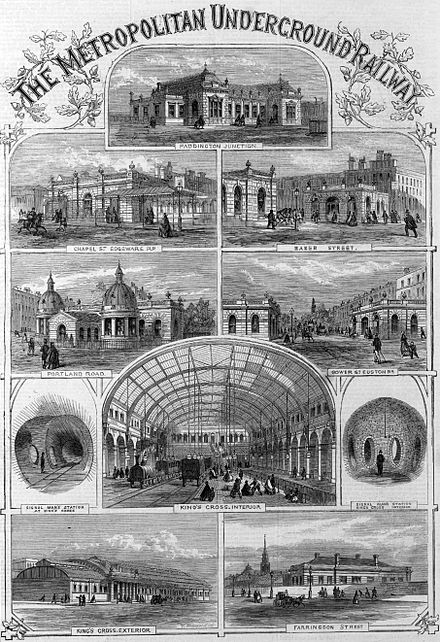History:
Congestion was a primary inconvenience for Londoners in the Victorian era. There was, of course, the heavy smog that filled the air due to industrial development, that was ever-oppressive. In addition to the air congestion, street congestion was another effect of the population increase of metropolitan London in the 19th century.
There were systems of railroads that connected the land outside of London to its borders, but no railway systems that served the inner-city areas. Due to this, commutes into the city from the surrounding suburbs were to be taken on foot, by cart, carriage, and the horse-drawn omnibus system. To reduce the street congestion, a remedy suggested by many Victorians was an underground railway system within the city itself (Williams, Culture and Society in London). The Metropolitan Railway was first proposed by Charles Pearson to the House of Commons in 1830 but was denied in 1846. He proposed it again in 1852 where it was approved and written into an infrastructure bill.
Pearson's Metropolitan line would function out of a central termini with multiple rail lines traveling out and connecting the rail systems out of London to the new intercity system. The intercity lines were set to begin in the Parish of Paddington and end in Battle Bridge (London Gazette). From Battle Bridge it was to connect to the Great Western Railway which serviced the southwest, West, Westmidlands and most of Wales. This increased access for residents of these areas to metropolitan London as well as increasing shipping ability into the City Center.
Construction began in 1852 and John Fowler, Baronet, was appointed as the lead engineer on the project (Green, The London Underground: An Illustrated History). It was determined that a “cut and cover” technique (a trench is excavated and then re-covered at the completion of construction) would be used to build the system. This technique was first undertaken between Kings Cross and Paddington Stations (Wolmar, The Subterranean Railway: how the London Underground was built and how it changed the city forever).
Unfortunately, construction was not without its difficulties. Many homes were disrupted either foundationally or they were destroyed in the excavation process. Additionally, there were a series of accidents that took place throughout the building process: a bowler explosion resulting in the death of an operator and his assistant, a tunnel collapse near Euston station, and lastly, a train car that overshot the platform and fell into a construction tunnel (Wolmar).
The Metropolitan Railway was completed and opened to the public on January 10th, 1863. The 6km stretch included stops at Paddington, Euston, Kings Cross, and the Railway Termini (Day, The Story of London’s Underground).
Effect:
The benefit the Metropolitan Railway provided England and more centrally London was substantial. It affirmed English ingenuity as the underground metropolitan train was the first of its kind. In the 21st volume of the Journal of the Statistical Society of London, William Arthur Wilkins argued for the creation of the railroad stating “[it] would convert the Great Western from the least convenient to the most convenient railway for the London passengers… It will not only afford ready and cheap access between the north-western and south-eastern parts of the metropolis, but it will relieve the streets of London from a large portion of that goods traffic which of late years [has] become so great a nuisance” (166). The railway did just that, reducing road congestion, furthering the convenience of the other railway systems across the nation, and making the transport of goods ever more efficient.
The Metropolitan Railway also beckoned in an area of work-life separation as it allowed for longer commutes. One could live miles away from their place of work as the railway created greater expansion in the suburbs of London - suburbs such as Middlesex. This reinforced the Victorian family as the distance cultivated a dissociation from work and a greater focus on the family and the home (Williams, London Culture and Society).
Relevance:
The Metropolitan Railways is pertinent to our course work this semester as we study Victorian Literature. Mobility was a key factor in the development of the Industrial Revolution as it allowed for quicker, more efficient transportation of goods and laborers. It also brought populations into more centralized metropolitan areas, such as London. As much of the canon of this course has settings in London, it is important to understand and reflect upon the infrastructure and development of infrastructure through this age. Additionally, it is key to evaluate how mobility affected the domestic life of the English, cultivating greater family ties and aiding in the rise of the middle class.
Works Cited:
Day, John R.; Reed, John. The Story of London's Underground (10th ed.). Capital Transport. ISBN 978-1-85414-316-7.
Green, Oliver. The London Underground: An illustrated history. Ian Allan. ISBN 0-7110-1720-4.
“Bayswater, Paddington, and the Holborn Bridge Railway”. The London Gazette. 30 November 1852. p. 3480.
Lee, Charles E. The Metropolitan LIne. London: London Transport. p. 7. ISBN 0-85329 033
"Total Population". A Vision of Britain Through Time. University of Portsmouth/Jisc. 2009.
Raymond Williams, Culture and Society (London: Hogarth Press, 1987)
Wilkinson, William Arthur. “Metropolitan Railway Terminal Accommodation, and Its Effect on Traffic Results.” Journal of the Statistical Society of London, vol. 21, no. 2, 1858, pp. 156–68. JSTOR, https://doi.org/10.2307/2338151. Accessed 9 Oct. 2022.
Wolmar, Christian. The Subterranean Railway: how the London Underground was built and how it changed the city forever. Atlantic. ISBN 1-84354-023-1.
Montage of Railway Stations. 1863. The Illustrated London News.

